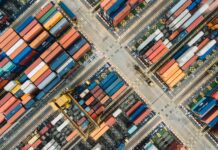
The market is heading into a traditional downcycle, as 2023 is seeing significant excess capacity being delivered, and in all likelihood, the same will happen in 2024, according to the latest Sea-Intelligence report.
According to the Danish maritime data analysis firm, the question remains of when the current and overcoming overcapacity market will balance again. In their latest report, the analysts define the most positive scenario, within reason, from the perspective of the carriers, as the following:
- Container volume growth of 3.8% Y/Y from 2024, matching the average growth of the post-financial crisis and pre-pandemic period of 2011-2019
- Supply growth in 2023-2026 based on the current orderbook
- Supply growth of just 1.3% for the period post-2026, matching the lowest level seen in the past 10 years (in 2016)
- A “structural factor” – i.e. how much faster supply can grow over demand, with the market remaining in balance – of 2.2 percentage points.

The figure shows the extent of the global over-supply, compared to the pre-pandemic norm of 2019, for the 2020-2030 period, given the assumptions above.
“So absent an explosion in global container demand, another pandemic soaking up capacity, or carriers laying up a significant share of the global fleet and ordering no more vessels, then we could see a 2019-level of supply/demand balance in 2028,” noted Alan Murphy, CEO of Sea-Intelligence.
He pointed out that “gaining this balance in 2028 would imply an eight-year span – the same as the cycle from the financial crisis until balance was restored again in 2017.”
According to the analysis, the worst of the overcapacity will be seen in 2024, and by 2026, one-third of the overcapacity will have been absorbed. However, if the assumptions underpinning the positive scenario are put in jeopardy by lower demand growth, even modest supply growth, or a lower structural factor, all of which are quite likely, then the 2019-level balance could be pushed out to 2030 or beyond.





